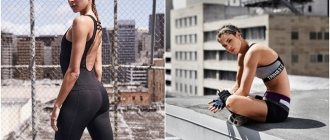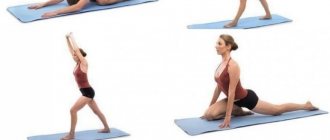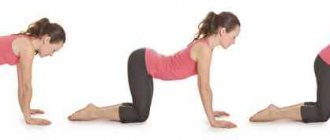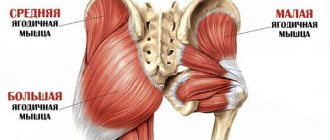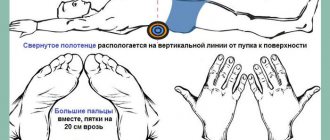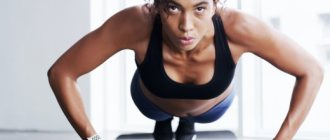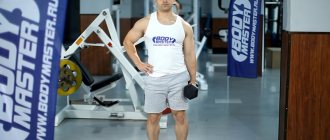A representative of the famous ballet dynasty, ballerina and actress Ilze Liepa is for many an example of elegance and excellent physical shape. Of course, her profession requires constant work on herself, but Ilze also “brings choreography to the masses” - she is the author of her own method of physical training. It is based on classical choreography and Pilates and is part of the studio program that Ilze Liepa opened for women who care about the perfection of their body. We offer a set of exercises from her book.
I called the express set of exercises “12 steps to grace.” I force myself to do this mini-exercise when I want to take a break from my profession, but not lose shape and muscle tone.
I am confident in the effectiveness of these exercises. I would like them to become your start to the day, morning exercises that will give tone, vigor, correct and strengthen the muscles of problem areas.
This express complex in no way denies your other activities, whatever they may be. This is also your lifesaver if you want to take care of yourself, but don’t know where to start.
For classes you will need:
- chair
- towel
- mirror
- free space
- wish
How to do the exercises correctly
- Breathing is an important element of any activity. It is advisable to inhale through the nose and exhale through the mouth. Please note that the exhalation corresponds to the most difficult moment of the exercise. (They often say: “Exhale for effort!”)
- When performing any exercise, try to reach up. The gaze is directed forward. The chin is perpendicular to the chest (maintain the natural curve of the neck). It will be great if you can keep your pelvis level. It is great when the lower part of the body is in a mid-position and the abdominal muscles are neatly tucked. This position of the pelvis allows you to engage the deep abdominal muscles, which is necessary for a toned stomach and is safe for the back.
- It is very important to keep the chest open at the top (gently pulling the shoulders back) and the lower ribs closed (as if pulled together by an invisible corset).
- Dropped shoulders, shoulder blades pointing down and towards the center are also very relevant. (Imagine taking the scarf off your shoulders.)
- When performing any exercises, choose a range of motion that is comfortable for you.
The reference points of correct body position should be maintained in any position - standing, sitting, lying, kneeling. It would be great if you made it a habit to start each session by reminding yourself of the important technical points. At first it is very difficult to control your body. At this stage, a mirror can become your assistant. It will prompt and show all the inaccuracies.
How do ballet exercises affect posture?
Very positive! “When a person begins classes in a ballet class, the first training sessions are aimed precisely at forming the correct position of the back,” comments Yana Tatarunis, ballet teacher at Alexander Mogilev’s dance school “IT”. — Because posture is the axis in dance on which all knowledge and skills are then “strung” in ballet.
Batmans, jumping - all this happens not only due to the strength of the legs and stretching, but also, perhaps, due to the work of the back.” Working on your posture is very important not only for aesthetic purposes (a straight back is the shortest way to “gaining” a beautiful bust and flat stomach). “It also ensures the normal functioning of the body and protects our musculoskeletal system from overload and injury. Due to the fact that posture aligns our body, the load is distributed evenly,” adds Yana Tatarunis.
The “mechanism” of ballet exercises is also interesting. “Ballet is a combination of flexibility and strength, and not masculine strength, but one that adds femininity,” notes Ekaterina Yurochkina, founder of the YaYaDance stretching and ballet school and author of the Online Fitness Ballet program . “This happens due to the fact that ballet uses internal muscles. Plus, ballet exercises are based on stretching the back. Moreover, not only the back is stretched, but also the neck. It is no coincidence that we admire the long, swan-like necks of ballerinas. There are also many exercises in ballet that involve opening the upper back. All this forms the royal posture. A healthy back, gracefulness and slimness without “male” fitness and external weights - this is what ballet and body ballet classes give.”
We speed up the result
In pursuit of the splits, it would be a good idea to use additional weights or exercise equipment. For example, the Nazarov biomechanical simulator is your reliable assistant in developing flexibility. This drug stimulates muscle contractions at a rhythm that is 40 times faster than the fluctuations during normal training. The simulator ideally warms up the muscles before stretching, and makes the exercises themselves safe and more effective. Thanks to it, the time it takes you to do the splits will be reduced several times. Exercises with the Nazarov apparatus will become much more effective. It was originally created for post-traumatic rehabilitation of athletes. However, after some time, its undeniable benefits were noted, including increased muscle elasticity. After this, the device began to be used not only for post-traumatic recovery, but also as an additional aid in stretching. In war, as they say, all means are fair! Splits for you!
Is ballet a strength or cardio exercise?
Both. “This is a mix of strength and aerobic exercise,” explains Ekaterina Yurochkina. — The secret of pumping is in a special inverted position of the legs. Thanks to it, we pump not only external, but also internal, deep muscles. The body becomes strong, but at the same time remains graceful and feminine. Also during training, we make sure to do a cardio peak - 5-7 minutes of ultra-effective cardio exercises (batmans, relevés, half-jumps). At this time, the most intense fat burning, drying and warming up of the muscles of the whole body occurs.”
Ballet exercises have a special effect on muscles. “If you warm up in a ballet class, all the exercises are aimed at making the muscle tense and at the same time stretch. That is, your muscles will become not only strong, but also elastic, soft, and long,” notes Yana Tatarunis. — We lift our legs both through muscle strength and stretching. One of the big advantages is that ballerinas, as a rule, do not have pumped up legs and arms, precisely due to stretching. There are muscles, they are very strong, long, beautiful.”
Thus, by performing ballet exercises, you can strengthen your muscles, visually tighten your figure and avoid excessive relief. “Unlike classes with external weights (dumbbells, kettlebells, etc.), ballet does not make the muscles bulging, but strong, smooth and elastic,” says Ekaterina Yurochkina. “Thanks to this, your whole figure seems to be “stretched”; your neck, legs, arms and even fingers become visually longer.”
About competition
The intensity of intrigue among these 5-6-year-old brats is amazing: in the fight for the coach’s attention, they beat each other in the locker rooms, dirty and cut suits, throw away equipment, and rejoice at other people’s injuries.
I loved it when I did something better than other girls. Oh, what happened at the performances! And cut pointe shoes, and throwing away a suit, and tearing a tutu. I caught one by the hand when she was pouring glass into my shoes.
The craziest thing is to add dichlorvos to your makeup. There is only one dressing room, but such creatures can pour everything into everything. At least acid.
Who is suitable for ballet exercises?
There are no age restrictions for ballet classes. “If a person does not have serious illnesses and is allowed physical activity in general, then there are no restrictions on ballet exercises,” notes Ekaterina Yurochkina. “Moreover, ballet and body ballet classes help alleviate some chronic problems. For example, related to posture and back. After one or two months of regular training, students forget about back pain, gracefulness, smoothness and ease of movements appear. Sleep improves and mood improves. As a bonus, students receive a toned body and minus 3-5 kg on the scales. Ballet promotes the harmonious development of the whole body, rather than its individual parts.”
However, if you have some health problems, you should treat ballet classes with caution. “Knee problems, flat feet, hallux valgus, large hernias and protrusions can be limitations to training,” adds Yana Tatarunis. — For such cases, doctors recommend separate therapeutic exercises. You can consult with a specialist and exercise with minimal stress on problem areas (for example, instead of half-toes, stay on the full foot).”
Losing weight in legs for ballerinas - about the rules
Hips, buttocks, ankles - these are the problem areas from which fat is most difficult to remove.
Achieving slimness along the entire length of the legs is a task of increased complexity. Diet is not able to sculpt the necessary contour. Having brought yourself to the point of exhaustion with a hunger strike, at best you can count on hopeless thinness and lack of muscles. Losing weight in the legs for ballerinas is a radically different process.
A special set of exercises allows you to burn fat and preserve muscle. For effective correction, you must adhere to the following rules:
- exercise regularly, ideally every day for at least 20 minutes,
- perform exercises 2 hours after meals or in the morning on an empty stomach,
- maintain a moderate-fast pace until your heart rate noticeably increases,
- You can have a snack at least 1 hour after class,
- reduce the amount of fats and carbohydrates,
- completely eliminate products containing sugar and wheat flour,
- increase the amount of protein, 50% of food is fresh vegetables and fruits.
Remember that the path of a ballerina is much more thorny. Those little efforts that we will have to make on the way to slender legs are within the power of any girl.
What mistakes are most often made in ballet classes?
These shortcomings can minimize all your efforts during ballet lessons.
- Incorrect posture. “Track it in all exercises,” says Yana Tatarunis. — Where does posture come from? From your feet. You should always stand very firmly on the floor and feel the floor. Next we explore our body. Let's look at where our knees are pointing. They must look towards the middle toe. The next very important point is our stomach. We do not draw it in so that the chest does not inflate, but we pull it up as we exhale. You will immediately feel it in your sacrum, your back will respond. We always have our chin parallel to the floor, and our head is slightly pulled back. Even if you remember your head, it will already align your spine.”
- Compensating for insufficient stretching with back movements . “For example, when bending towards the leg, many people begin to bend their back, this is incorrect,” adds Yana Taturnis. “It may not be as low as you expect now, but it will be royal.” You have two straight hips, two straight shoulders, and you always bend slightly diagonally with your stomach, then your chest, and only then your head.”
- Incorrect breathing. “During classes we always breathe very evenly and calmly,” says Jana Tataruns. — It is important to make the main effort and extension while exhaling. Why? Because when we exhale, our muscles unclench. A tense muscle is very hard and not elastic. As you exhale, your muscle lengthens, making it easier for you to perform the exercise. We always exhale into the muscles, making some effort.”
Longitudinal twine
Contrary to the established stereotype, it is not much easier to sit on a longitudinal split than on a transverse split. Even if flexibility is good, preparatory exercises are required to avoid injury and sprains. The basic rules remain the same. We would like to draw your attention to the fact that any position must be fixed for at least a minute. This will allow the muscle to get used to the load and prevent injury. If you have time, repeat the exercises several times on each leg. And remember, the better you warm up, the more effective the session will be. Always do the same load on both legs, even if you prioritize splits on a particular side, so the muscles will stretch evenly.
Which ballet exercises are suitable for everyone?
We asked experts to create a set of ballet exercises that will help improve posture and strengthen major muscle groups. Do them all (if you want to work all the muscles of the body) or only those that involve one specific area of the body.
How to build a lesson
- Start your workout with light joint exercises .
- Perform all exercises in 3 sets of 8 repetitions each.
- Take your time and strictly follow the technique of performing the exercise.
- Do this program 3-4 times a week.
To perform the complex you will need a mat, a towel and a high-back chair (or a window sill).
Active warm-up
Comment by Yana Tatarunis: “This exercise stretches the thoracic region well. This is the basis of our posture, since first of all, all violations are visible here - stooping or bending. A well-developed thoracic region returns the back to the correct position and improves the functioning of all internal organs.”
Stand straight, place your feet shoulder-width apart, toes forward. Distribute your body weight evenly across your entire foot and straighten your back. Raise your arms up as you inhale and open your chest strongly, look at the ceiling, stretch your back over the entire surface. Stay in this position for 3-4 seconds. Watch your shoulders so that they do not rise towards your ears following your arms. As you exhale, open your arms to the sides and move them forward, placing your palms in front of you. Interlock your fingers and very, very round your back like a cat. At the same time, slightly bend your knees. At the same time, the tailbone is curled, perform 8-10 repetitions.
First exercise
Comment by Yana Tatarunis : “An exercise with a towel is also good for stretching the thoracic region (can be replaced with a jump rope, an elastic band, a belt, a robe belt). My favorite exercise, and probably all dancers like it. It opens the chest well, plus the shoulder blades and middle back work.”
Take a towel with both hands, stand up straight, spread your palms wider so that the shoulder joint is not pinched when moving. Place your feet shoulder-width apart, toes pointing straight. Smoothly raise your arms above you and try to move them back as far as possible, holding a towel in your palms, then return to the starting position. There is no need to rotate the shoulder joint completely, as gymnasts do. Perform 8-10 repetitions of the exercise.
Second exercise
Comment by Yana Tatarunis : “You can also work on the muscles of the back, thoracic region and slight stretching. This is what shapes our posture. To perform this exercise, you will need a sofa or chair. In ballet class, we usually use a barre, chair or other available furniture.”
Lie on your stomach with your head facing the sofa, arms extended along your body. Smoothly lift your chin, head, and back above the floor (as if someone is pulling you back by your hands). Exhale for a second or two, slowly move your arms forward without lowering your body. Place your hands on the sofa, leaning on it, try to rise with straight arms, looking down. The main thing here is to avoid painful sensations and not to try to “push” beyond your limit. Lock this position. Without lowering your body, spread your arms to the sides, then press them to your body. Smoothly lower yourself to the starting position and perform 8-10 repetitions.
Third exercise
Comment by Yana Tatarunis: “Here we use the back of the thighs, which is connected by the rectus longus muscle to our back. Strong and stretched legs also shape our posture by taking extra pressure off the back.”
Stand in front of a chair, put your hands on the back, lean your head and body slightly forward. Lift your right leg back, pointing your toe down. Feel the work of the buttocks and the back of the thigh. Raise your leg enough to form a straight line from your back to your leg. While holding your leg in this position, begin to slowly and smoothly rotate your right knee and hip to the right. Stay in this position for 2 seconds, then rotate your foot and hip back without lowering your foot to the floor. Perform 4 more of these movements, then lower your foot to the floor. This is one approach. Do 2-3 of these in each direction.
Fourth exercise
https://cms.jv.ru/wp-content/uploads/2020/05/1-1.mp4
Comment by Ekaterina Yurochkina
: “
This is an exercise for graceful ballet hands.
When performing it, control the position of your neck and shoulders - do not strain them.” Stand straight, smoothly raise your arms to the sides at shoulder level. Bend your elbows and lower them down, pull your hands closer to your face, then push them out to the sides again. Keep your back straight and reach up with the top of your head. Perform 8 smooth movements - this is one approach. Then slowly lower your hands down and shake lightly. Perform 3 sets of exercise.
Fifth exercise
Get into the first position: heels together, toes apart, shoulders pulled down, back straight, reach up with the top of your head. Place your hands in front of you. Then smoothly lift them up, lower them to the sides and down. This will amount to one repetition, perform 8 such repetitions. Rest for 20 seconds, then perform 2 more sets. Then perform 3 more sets, repeating all movements at a fast pace.
Sixth exercise
Comment by Ekaterina Yurochkina:
“This exercise helps stretch the lateral back muscles. During classes we usually use a ballet barre, but at home any support will do: a chair, a table, a window sill.”
Stand with your right side to the support, taking the first position: heels together, toes apart. Stretch your crown upward. Move your left arm to the side, tilt your body towards the support, stretch up and to the right. Perform 8 inclines. Then do 8 counts of bending over, this will make one approach. Do 3 of these in each direction.
Seventh exercise
Comment by Ekaterina Yurochkina:
“
This exercise will help you quickly relax and stretch your back and shoulders, especially important after a long day of work.”
Stand facing the wall (you can use a chair or table), place your feet slightly wider than your shoulders. Stretch your arms up, bend over, and press your palms against the wall. “Sag” your body down a little, legs and elbows straight, back straight. Stay in this position for a few seconds. Next, twist slightly in the thoracic region and return to the starting position. Perform 6-7 such movements.
Eighth exercise
Stand facing the wall (you can use a chair, table, ballet barre, etc.), with your feet wider than shoulder-width apart. Stretch your arms up, bend over, and press your palms against the wall. Bend your back down and stay in this position for 8 counts. Then bend your knees slightly, keeping your back arched. Straighten your knees. This will amount to one repetition, perform 8 such repetitions.
Do this program 3-4 times a week or more often if you feel the need. Try to gradually increase the load by speeding up the pace or increasing the number of repetitions in the exercises.
Cross twine
The transverse split is considered the most spectacular and impressive. Not surprisingly, it requires a lot of effort and intense training. For many, it remains the ultimate dream. However, if you strictly follow the rules and train regularly, it will become your favorite exercise. To begin with, we suggest that you familiarize yourself with the basic rules that must be followed while stretching: Mandatory warm-up
. Before you start stretching, be sure to warm up your muscles. This could be running, jumping, squats, and even a little leg training. Physical activity will ensure blood flow, prepare muscles, make them firmer and more elastic. In addition, special attention should be paid to warming up the hip joints. Leg swings, scrolling and circular movements of the pelvis will help you here;
Systematicity
. If you want to do the cross splits, regular training is the key to success. You will need to develop the flexibility necessary for the splits and accustom your body to the load. At first, it is recommended to exercise once every 2-3 days, later, when your body gets used to it, the number of workouts can be increased;
Warming up
. You need to train in a heated room where there are no drafts. Even during warm periods, wear a T-shirt, leggings, and leggings. This will allow your body to warm up, which will ensure muscle elasticity;
Do not overdo it
. No matter how strong your desire to do the splits, remember to take precautions. Excessive pressure and sudden movements can lead to injuries that will close the door to the world of splits for a long time. Be careful, feel your body and listen to the sensations. There must be pain, but it is tolerable and even a little pleasant. If you are in unbearable pain, then you have violated one of the above points;
Like-minded people
. Work out in a group, or with a person who knows a lot about stretching. If there is someone nearby who can help you, advise you, and explain the principle of doing the exercises, the result will come much faster.
